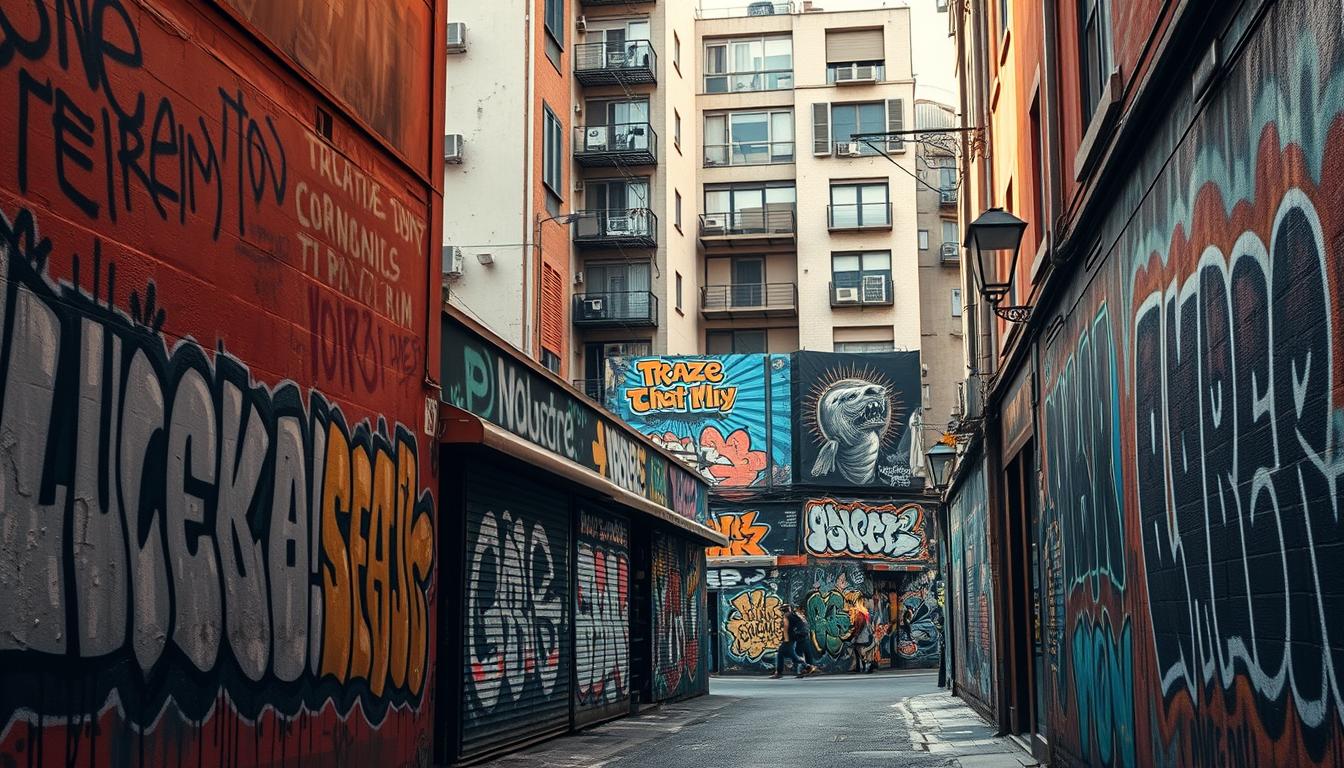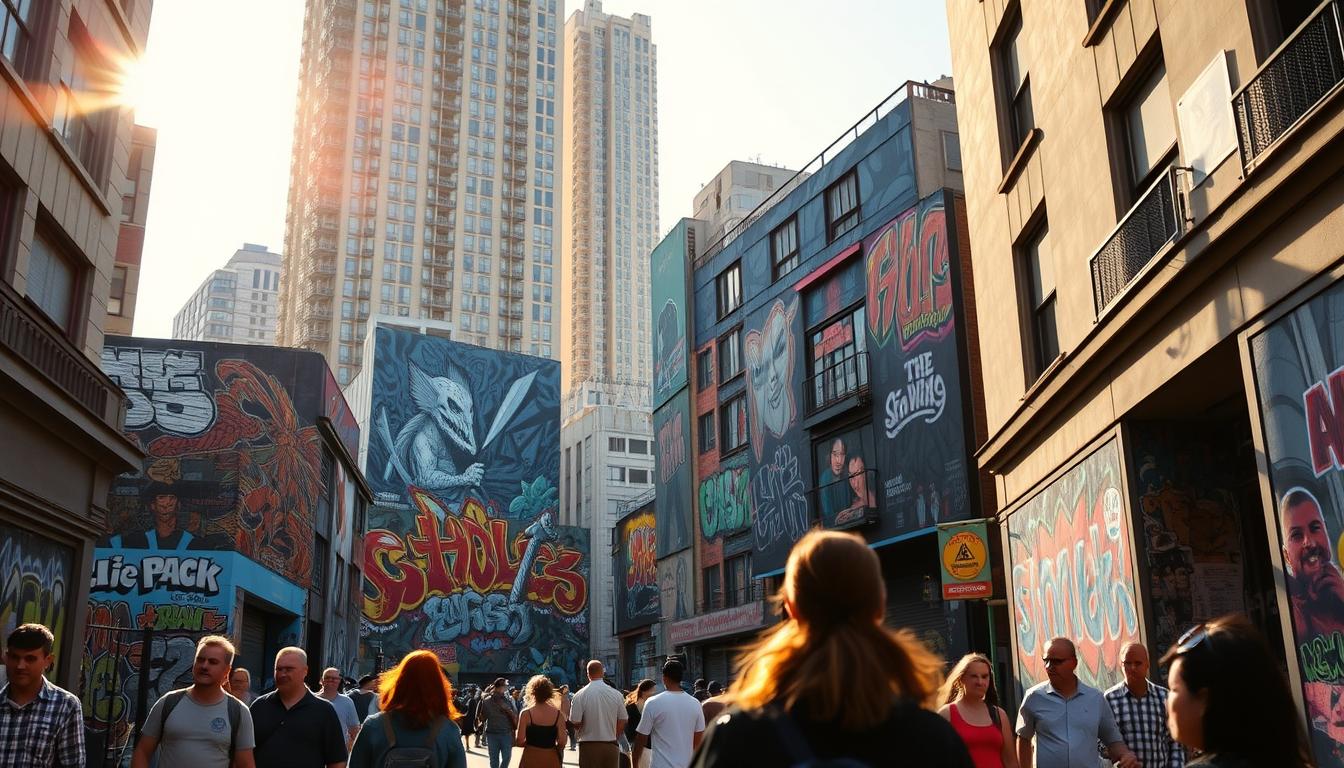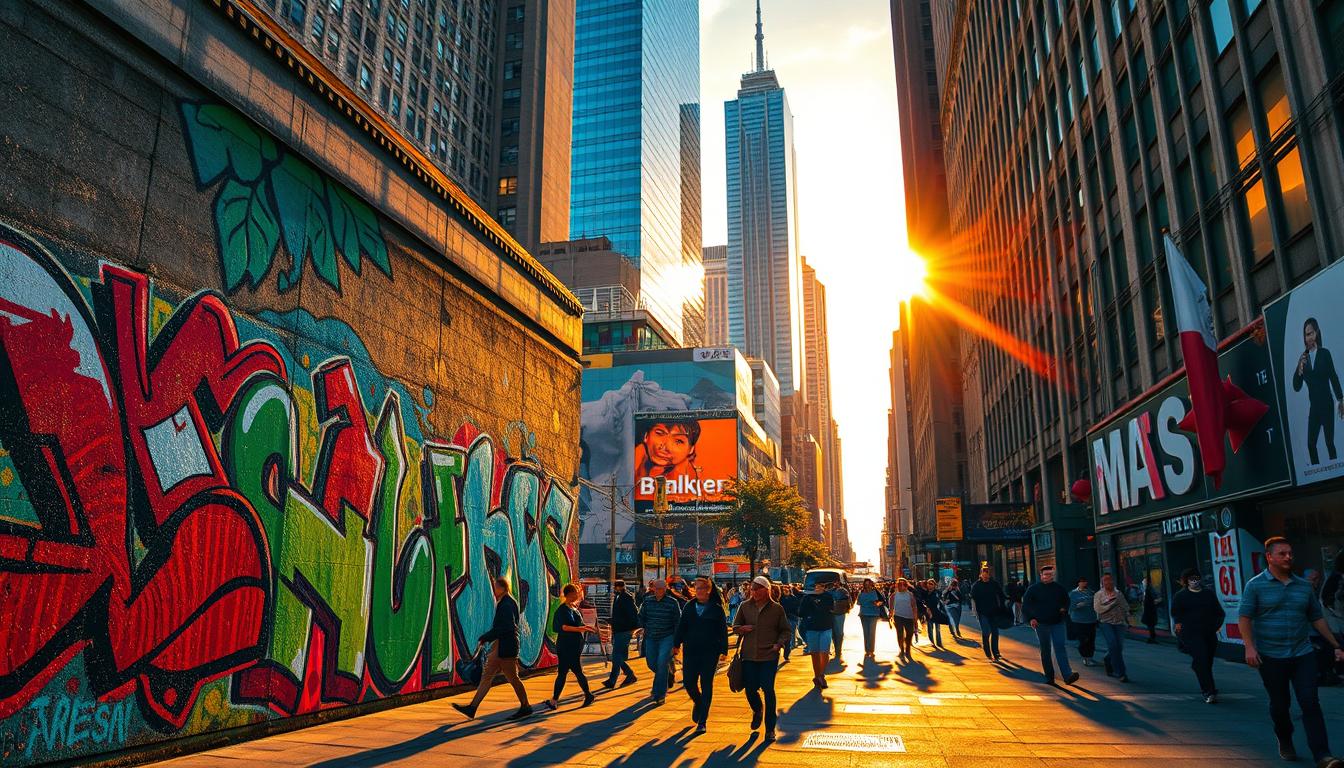Can a mural that draws tourists mean the same thing as a name scrawled in a subway?
Let’s clear the air: one practice aims to reach a broad public with images, scenes, and installations, while the other centers on name-based writing made for a tight community of writers. This basic definition sets the stage for a closer understanding of intent, audience, and legality.
Permission often separates the two. Cities and property owners commission murals and programs, and festivals showcase visible work that invites viewers. By contrast, many writers seek risk, placement, and peer respect while avoiding capture.
The visuals differ too: large image-based pieces, stencils, and installations sit alongside tags, throw-ups, and wildstyle lettering on the same walls. Expect real U.S. examples next — think Wynwood Walls or a subway pillar — to anchor those contrasts.

Key Takeaways
- Street art targets a broad public and often has permission; graffiti usually serves a writers’ community and is often illegal.
- Visuals split: murals and images versus name-based lettering and tags.
- Intent differs: public engagement versus peer recognition and presence.
- City programs and festivals boost public-facing work and tourism.
- Both share walls, but context and culture shape how each is seen.
Street art and graffiti at a glance: definitions, examples, and a brief history
On city walls you’ll find image-driven pieces and quick, name-focused marks that tell different stories.
Definition: public image-led practices
Street art covers murals, stencils, wheatpaste posters, projections, yarn-bombing, and installations. These forms favor visibility and public engagement. Artists often use painting, spray techniques, and layered posters to communicate clear messages to passersby.
Definition: name-based writing
Graffiti centers on a chosen name or signature. Common forms include tags, throw-ups, wildstyle pieces, stickers, and paste-ups. Speed and placement matter: simple markers and two-color throw-ups help writers mark many walls and hard-to-reach spots.
History snapshot
Modern graffiti surged in New York as subway writing in the 1970s and 1980s. Figures like Seen and Cornbread made names famous. Photos, books, and films then spread the look worldwide.
- Example: a large painted scene honoring a neighborhood (public mural).
- Example: a repeated stylized signature across a block (writer tag).
How is street art different from graffiti: core differences explained
Names, placement, and permission shape two very different public practices on city walls.
Naming, audience, and intent
Writers often use a moniker and repeat a quick tag to gain standing among peers. Anonymity and speed matter; risky spots win respect.
By contrast, many artists sign with real names and plan pieces that speak to a broad public. Murals and stencils aim for legibility and engagement at a glance.
Legality and places
Permission separates many commissions and festival work from illegal name-based marks. In a city, sanctioned murals support placemaking, while unsanctioned runs are labeled vandalism and carry legal risk.
"Placement, purpose, and permission tell you whether a mark seeks public dialogue or peer recognition."
- Naming: monikers vs. signed credentials.
- Audience: writers’ networks vs. anyone walking by.
- Places: high-risk heavens and bombing zones vs. commissioned walls and festivals.
Takeaway: who it’s for, why it’s made, and whether it got permission are the fastest cues to spot the core differences. For a deeper read, see graffiti vs street art.
Materials, visuals, and formats: from spray and markers to murals and installations

Tools and media
Graffiti often relies on spray cans and markers for speed. Tags, throw-ups, and wildstyle lettering use quick tools to mark many walls fast.
Street art brings stencils, wheatpaste posters, yarn bombing, video projections, and large-format painting. Installations and 3D pieces expand work beyond flat surfaces.
Visual focus
Name-based lettering and signatures cue graffiti. If the focal point is a stylized moniker, readers will note letter technique first.
Image-led scenes, portraits, or symbolic images point to public-facing work. These aim for immediate recognition and clear messages for passersby.
Examples you’ll see
- Tag on a shutter or a quick throw-up on a train car.
- Blockbusters and wildstyle pieces that show complex lettering skill.
- Multi-story murals, paste-up portraits, and projection-mapped facades.
- Stickers and paste-ups that may cross both forms depending on intent.
| Aspect | Fast, name-led | Image-led, public | Shared items |
|---|---|---|---|
| Tools | Spray, markers | Stencils, paint, posters, installations | Stickers, paste-ups |
| Visual cue | Lettering, monikers | Scenes, characters, messages | Small graphic tags or logos |
| Example | Rounded throw-up | Community mural | Sticker campaign on poles |
| Tempo | Fast, evasive | Planned, often permitted | Varies by intent |
Quick field test: if the work centers on a stylized name, it likely leans graffiti; if it centers on an image meant for everyone, it likely leans street art.
Culture and perception: community, risk, and how people see the work
Subcultures build rules that shape what counts as respect or provocation.
Culture and etiquette
Within writer circles, a tag over another's piece can mean an open challenge. That act follows an accepted code: territory, rivalry, and visibility shape behavior.
Respect often comes from daring placements and steady presence. High-risk spots and repeat work raise a writer's status among peers.

Public perception and commerce
Many cities view permitted pieces as neighborhood beautification. Programs like Wynwood Walls, the Bushwick Collective, and Jersey City Mural Arts turn commissions into visitor draws.
By contrast, unauthorized marks often get labeled vandalism and face removal. That label affects how people and officials respond to works.
- Etiquette: tagging over others is an aggressive, culturally coded move.
- Respect: risky placements and consistency build reputation among graffiti artists.
- Public-facing norms: many artists now sign, sell prints, and accept commissions without stigma.
- Crossovers: some creators start with New York train writing and later join festivals or legal walls.
"Different audiences, different stakes, and different places shape how communities react to marks on walls."
Takeaway: subculture norms and public opinion both shape the perceived value of a piece. These forces explain many of the key differences between street art and graffiti in U.S. cities today.
Similarities and overlap: shared spaces, politics, and cross-over artists
Urban walls host a surprising overlap where public images and name-based marks meet and talk back to each other.
Where they meet
Both practices appear in public locations. They use spray cans, stencils, posters, and markers. Both deliver political and social messages visible on sidewalks and avenues.
Shared ground and examples
They shape contemporary visual culture. Galleries now show works that began on streets. Advertising and design borrow motifs and energy.
- Both use similar materials and can carry clear messages to any passerby.
- Some artists move between quick name work and large murals or studio pieces.
- Example: Banksy's unsanctioned stencils reach broad publics and later appear in museums or sales.
"Overlap doesn't erase the core split: name-based peer recognition versus image-led public communication."
On a single block you may find a large mural beside layered tags. Viewers judge pieces by intent, placement, and audience.
Takeaway: Recognize similarities without ignoring the main distinctions. Both fuels keep our streets alive and rich with creative energy.
Conclusion
A simple checklist helps you tell a bold mural apart from a rapid name mark.
Quick test: if the focus is a signed image or mural meant for the public, it likely falls under street art; if the mark centers on a moniker, tag, or stylized name aimed at peers, it likely reads as graffiti.
Legality and places matter. One often appears via permits, festivals, or city programs and fuels tourism, while the other often risks removal and can be treated as vandalism. Visual cues help: murals, stencils, posters, and installations contrast with tags, throw-ups, and wildstyle lettering.
Both forms share walls and streets and sometimes the same artists move between them. For a clear primer on the difference between street art and graffiti, use the audience, focus, and permission checklist to read any artwork you meet on city walls.
Enhance Your Space with Unique Modern Masterpieces
Are you inspired by the innovative mediums and conceptual depth highlighted in our exploration of contemporary art? You’re not alone! Today’s art enthusiasts are seeking cultural relevance and emotional connections in their artwork. However, finding pieces that resonate with modern themes and fit your unique style can be a challenge. That’s where we come in!
At Rossetti Art, we specialize in canvas prints, original paintings, and modern sculptures that celebrate the spirit of now. Each piece created by Chiara Rossetti brings a personal touch that connects deeply with current social narratives—just like the modern masterpieces discussed in the article. Don’t miss out on the chance to elevate your home decor with breathtaking artwork that speaks to your values and aesthetic. Explore our collection today and find your perfect piece! Act now, and transform your space into a gallery of inspiration!
FAQ
What counts as street art?
Street works include murals, stencils, wheatpaste posters, sticker art, and site-specific installations. These pieces often focus on imagery or messages and may appear with permission at mural festivals, on commissioned walls, or as temporary public projects.
What counts as graffiti?
Graffiti covers tags, throw-ups, wildstyle lettering, stickers, and paste-ups that emphasize names or crews. Writers create these marks quickly with spray cans or markers, often in transit hubs, alleyways, or urban surfaces without formal permission.
Where did modern graffiti begin?
Modern letter-based writing rose in New York City during the late 1960s and 1970s, when subway writers like Taki 183 popularized tagging. This scene evolved into complex styles and crews and later spread worldwide, influencing other urban movements.
Who are “writers” and how do they differ from muralists?
Writers focus on name recognition through tags and stylized lettering. Muralists usually aim at broader audiences with figurative scenes, social messages, or decorative imagery. Both may share skills, but their goals and publics often differ.
Are these practices legal?
Legality depends on permission and location. Commissioned murals and sanctioned projects are legal. Unauthorised tagging or painting on private or public property can be considered vandalism and carry fines or arrest.
What tools and materials do artists use?
Common tools include spray paint, markers, aerosol caps, and stickers. Street artists also use stencils, wheatpaste, rollers, projection mapping, and installation materials like fabric or found objects for larger displays.
How do visual goals differ between the two?
Writers prioritize name style, flow, and reputation, often using lettering as the central element. Other urban artists aim to tell stories, create scenes, or deliver political messages through imagery and composition.
Can the same person do both styles?
Yes. Many practitioners switch between lettering and pictorial work. Artists such as Banksy and Shepard Fairey started with stencils and stickers but also produce large-scale murals and public projects that blur genres.
What social roles do these works play in cities?
Both forms offer social commentary, community identity, and visual activation of neglected spaces. Murals can boost tourism and commerce when commissioned, while unsanctioned pieces may spark debate about ownership and public space.
How do communities and crews enforce etiquette?
Writers use unwritten rules about respect for other people’s pieces, territory, and ranking. Crews and local communities may discourage tagging over detailed murals, though conflicts over space still occur.
What are common examples found in urban areas?
Look for tags on alley walls, throw-ups on train yards, blockbusters on large facades, wheatpaste posters on lamp posts, colorful murals on building sides, and projection art during events.
How has public perception changed over time?
Perception shifted as cities embraced mural festivals and commissions, framing some work as beautification. At the same time, unauthorised markings still face stigma as vandalism, creating a complex cultural view.
Where do street-based politics and activism appear?
Public walls often host protests, memorials, and awareness campaigns. Both lettering and image-driven pieces serve as immediate tools for political speech and community response in public spaces.
What safety and legal tips should creators follow?
Seek permission for walls, learn local ordinances, use proper safety gear for heights, and respect private property. Participating in sanctioned projects reduces legal risk and can provide wider exposure.
How can the public support positive projects?
Support comes through commissioning local artists, attending mural festivals, donating to arts non-profits, and advocating for legal walls that allow creative expression while protecting property rights.






Leave a comment
This site is protected by hCaptcha and the hCaptcha Privacy Policy and Terms of Service apply.